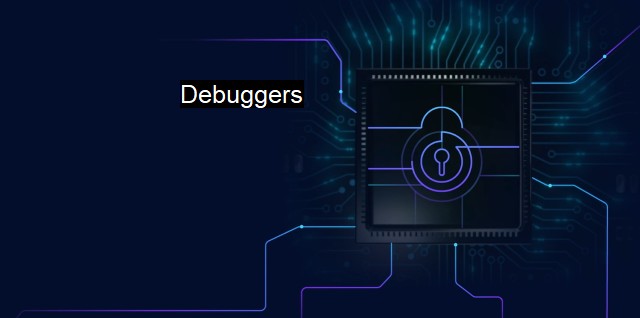What are Debuggers?
The Power of Debuggers in Cybersecurity and Antivirus: Eliminating Errors and Vulnerabilities in Software Code
Debuggers are specialized software tools used in the field of cybersecurity and antivirus development in particular, for the analysis and elimination of errors, known as "bugs," that plague our digital lives. They are essential because digital systems are increasing in complexity; thus, the possibility for minor faults which can create serious security weaknesses is also on the rise.In the cybersecurity realm, a debugger’s function extends beyond simple defect resolution. It has a significant role in identifying vulnerabilities inside an application. a debugger allows the developer to inspect the internal states of a program during its execution, permitting real-time, interactive investigation.
The most basic functionality of a debugger involves starting a program, triggering breakpoints (intentional stopping or pausing places in a program), and examining the variables. Advanced debuggers offer more complex functionalities like running a program step by step (also known as stepping), moving backwards to a previous state (also known as backstepping), or changing the value of variables on the fly.
Naturally, debuggers are powerful allies for malicious hackers too. Armed with these tools, they can dissect a program to understand its structure, locate vulnerabilities, and devise attacks. To counteract this, cybersecurity experts employ various practices like anti-debugging techniques, which involve the application detecting if it's being run under a debugger and then either altering its behaviour to withhold information or even halting execution altogether.
From an antivirus perspective, debuggers can be immensely helpful. Not all malicious code arrives in the form of readily identifiable viruses. Debuggers can be used to analyze potentially malicious code, including those hidden deep within layers of benign-looking software. They can help researchers and analysts break down the software and isolate these harmful segments for removal or quarantine.
Sometimes, specialized debuggers are developed specifically for the world of malware and antivirus. These debuggers focus on the machine language level instructions run by a program, including malware indicators like encrypted strings of executable code. Such debuggers expose potentially hidden malware actions, revealing malware decoy techniques and even harmful payloads embedded within the code.
Debuggers and antivirus software work closely together in the cyber threat landscape. An antivirus software will commonly include a sandbox environment, a controlled and isolated space where suspected malware can be safely executed and observed. Using debuggers, cybersecurity experts can then step through the programs, studying its behavior without the risk of contamination to the main system.
Beside detection, debuggers are also used in the antivirus reverse engineering process. Reverse engineering is the practice of disassembling software, which is a crucial component of malware analysis. In this process, debuggers are used to understand how the malware functions, its thought process and deciphering its strategy.
While the use of debuggers within the context of cybersecurity and antiviruses displays their critical role in testing and refining a system's defenses, they emphasise more importantly on the continuous need for careful observation and understanding. Like the unfolding logic of codes and programs, the world of cybersecurity deals equally in uncertainty and guesswork.
The best guard against these elusive threats lie in continuous debugging, inspection, and fortification of our digital systems. It is through these continuous steps of debugging, aided largely by debuggers, that security professionals are able to study, anticipate, and prepare for the ever-evolving threats. Debuggers, therefore, serve a daunting task in the domain of cybersecurity and antivirus software; supporting the war against cybercrime by helping detect, dissect, and decimate digital threats.

Debuggers FAQs
What is a debugger?
A debugger is a software tool that allows developers and cybersecurity experts to find and fix errors or bugs in a program's code. It helps in identifying and resolving issues, testing and optimizing software, and preventing potential security vulnerabilities.How do debuggers work?
Debuggers work by allowing users to execute code step by step, set breakpoints where the code execution stops, and examine the program state at that point. Users can inspect variables, memory, and registers, and analyze how the program behaves at different stages. By analyzing the program's behavior, users can identify the source of errors, bugs and security vulnerabilities.What are some common debuggers used in cybersecurity?
GDB (GNU Debugger) is one of the most commonly used debuggers in cybersecurity. It's a command-line tool that works on multiple operating systems and architectures. OllyDbg is another popular debugger for Windows platforms. WinDbg, IDA Pro, and Immunity Debugger are other commonly used debuggers in cybersecurity.Can debuggers be used for malware analysis?
Yes, debuggers are often used for malware analysis to understand how the malware works and to identify possible countermeasures. Debuggers can help in identifying the malware's payload, network communication, and command and control (C&C) servers. They can also assist in identifying evasion techniques and anti-analysis measures used by the malware.Related Topics
malware analysis reverse engineering vulnerability assessment code obfuscation exploit detection
| | A | | | B | | | C | | | D | | | E | | | F | | | G | | | H | | | I | | | J | | | K | | | L | | | M | |
| | N | | | O | | | P | | | Q | | | R | | | S | | | T | | | U | | | V | | | W | | | X | | | Y | | | Z | |
| | 1 | | | 2 | | | 3 | | | 4 | | | 7 | | | 8 | | |||||||